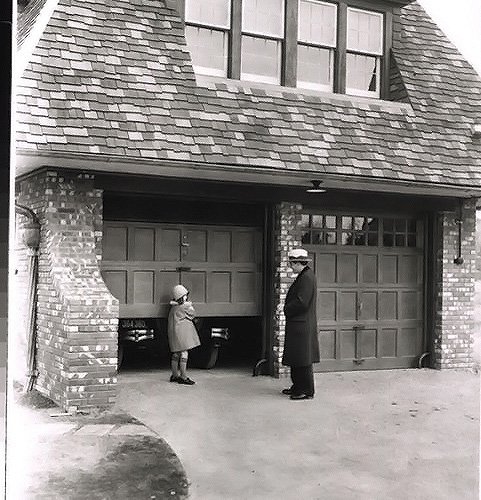The Story of the Modern Garage Door
As Henry Ford was mass-producing automobiles and barns were being transformed into houses, America needed a new way to safely store and easily access their cars. Out of this need, a man took an idea and turned it into a legacy. In 1921, C.G. Johnson began a journey to bring the upward-acting, sectional garage door to America and forever change the way people enter their homes. 100 years later, the Overhead Door™ Brand is keeping the legacy alive with more than 450 distributors in North America who proudly bear the iconic Red Ribbon logo.
Our Beginnings
At the turn of the twentieth century, car owners realized they needed a new kind of outbuilding dedicated to storing their cars alone. Traditional barn or carriage house doors opened toward the outside like standard doors. This method was problematic, as the doors were heavy or were blocked by impediments like snow, debris, or grass. It was also precarious as the hinges would easily wear and break. The doors would need a large space that needed to be kept clear of obstructions and was severely lacking in security. Keenly aware of these shortcomings, CG Johnson and Overhead Door Corporation revolutionized the way people stored their cars forever by inventing away the doors would lift to become parallel with the roof of the garage. At the time of his endeavor, architects were hailing the invention of this ‘new kind of outbuilding’ and calling it a garage; a word derived from the French word garer, which means to shelter or protect. The door was made with hinged panels that could bend as the door lifted, and this was a vast improvement over the old carriage house doors.
In 1921, Johnson partnered with Owen Dautrick to start the Dautrick-Johnson Manufacturing Company which would later become Overhead Door Corporation. Together they began producing the first “upward-lifting garage door”. Johnson later worked with attorney Forest Mckee of Hartford City, Indiana to start the company’s first plant in Detroit. It was a 1,000-sq.ft. building with a production capacity of one door per day. After acquiring a patent for the automatic opener, C.G. Johnson and his wife spent the next few years touring the country with a miniature garage door mounted on the back of a Model T Ford truck signing up dealers. These were the first red ribbon distributors, beginning a generational legacy of trusted service that has been passed down for 100 years. In 1923, while stopped at an Indiana trade show, a local enthusiast was impressed by the garage door and offered Johnson a factory site. Johnson agreed, and in 1924 the factory moved to Hartford City, Indiana with a new plant of 200,000 sq. ft. of manufacturing space allowing mass production of garage doors. Three years later, Johnson recruited Herbert Cady Blodgett who had just invented the first electric garage door opener in Hartford City, Indiana. Together, they began producing the modern garage door system as Overhead Door Company of Hartford City.
At a time when cars were replacing horses as the primary mode of transportation, Johnson and his revolutionary associates were true innovators who adapted to the rapidly changing world, creating a solution that homeowners everywhere needed with the modern garage door and the automated garage door opener. These inventions grew into a business and a brand that has stood the test of time. While the company has evolved and grown over the years, the Red Ribbon is still known for its quality, service, and integrity.
Strategic Business Plan Led the Way
Johnson built an innovative display of an operating garage door on the back of a model T truck to advertise the prototype of this invention across small towns to the car, home, and builder shows. As the eye-catching showroom on wheels, this display turned heads at the Detroit Auto Show. That early move earned him a flattering article in the Detroit Free Press which mentioned 800 doors had already been installed and showcased the impressive adoption of his new product. Being on the road for the next several weeks, Johnson found people embracing the convenience of modern technology.
Not only was Johnson selling to consumers and builders; he was selling communities on the idea of building garage door factories in strategically located sites around the nation. As the garage continued to gain popularity across the country, so did the door that shared its name. In May 1923, Hartford City’s Chamber of Commerce began selling stock to build a garage door factory. By April 1924, the Lewistown Chamber had raised funds for the plant in Pennsylvania. The cities continued to grow and both plants would employ hundreds of workers for decades to come. All of which began from one compelling sales pitch by C.G. Johnson.
Connected to Community
Johnson was heavily supported by the chambers of commerce in both Lewistown and Hartford City where he proved his commitment to the community. In both cities, Johnson partnered with the community by selling stock in the factory and allowing the locals to be part of the success of Overhead Door Corporation.
According to Tom Wadsworth from DASMA, When the stock market crashed and the Great Depression hit in late 1929, Johnson kept Hartford City alive and even added more factories despite the economic crisis. In 1930, the company then announced a “job-for-everyone” plan during the Christmas holidays. Employees were proud to belong, and the quality of work showed it. This is the legacy thousands of professionals have built the Red Ribbon on. Showcasing that to be pioneers in the industry, you must have the best people.
History and Changes to Bring Steady Growth
Johnson served as president until 1935 when Forest McKee succeeded him. The business was strong during the remaining years of the Depression. Architects began designing homes with garages attached. This made garages as convenient as possible, allowing homeowners to access their vehicles without having to step out into the elements. After World War II, cars grew larger and larger, and many households began to own two vehicles. Garages grew to accommodate multiple larger vehicles.
Following the death of McKee in 1951, his brother Paul assumed the presidency. By 1956, the company expanded its expertise in making upward-acting sectional garage doors to trucks and trailers, forming TODCO.
By the 1960s, the garage represented about 45% of a home’s square footage and having a garage with an electric opener was the norm. This made it more convenient and safer for homeowners. Overhead Door Corporation began to buy out the franchised operations that had served the company so well in the early years. It also remodeled existing facilities and opened new door manufacturing plants.
Wood Door No More
Over the next several decades, technological advancements allowed for the creation of new door styles and materials. Throughout most of the 20th century, garage doors were made of wood. The 1970s brought a shift in materials, making steel, aluminum, fiberglass, and other materials. These new materials were a predecessor to the unmatched options home and business owners enjoy today, including composite materials with synthetic insulation. Aluminum and glass garage doors have also become popular with the owners of contemporary homes.
By the end of the century, steel garage doors dominated the industry, and homeowners were introduced to a new innovative combo offered by many manufacturers – the look of wood combined with the durability of steel. Today, the old is becoming new again. The carriage house style has made a comeback with its barn-style doors and classic charm, both of which are sought-after features for garage doors. Since 1921, garage doors have seen massive improvements and advancements. They are safer — thanks to photoelectric eyes and other sensors that stop the door from coming down if there is something underneath it. They are tougher because of materials like steel, aluminum, and composites. They offer more protection, thanks to insulation options, and they also look better.
Why We Have the Name – Garage Door Experts
A lot has changed since we installed the first modern garage door in 1921. The transformation from converted carriage houses into the garages that we see today has a long history. Garages have gone through various eras and changes as society developed, with the needs of people being met through these modifications such as storage for auto mechanic tools and other needs. The technological and social trends throughout time influenced the evolution of garages, to the extent that they have now become an integral part of our daily lives.
One thing that hasn’t changed is our commitment to quality. We continue to hold ourselves to the highest standards when it comes to professionalism, product, and innovation. We didn’t just invent the sectional garage door; we’ve been leading the industry for the past 100 years. Millions have looked for us and trusted the red ribbon because of our unequal customer service and expertise.
Continual Focus on Innovation and Our People
Throughout the country, we have local family-owned businesses dedicated to supporting home and business owners. Each of these locations has a deeper knowledge of the area and develops relationships with each customer that walks through the door. Our employees live by the values that have made our company the leader it is today.
As pioneers in our industry, we continue to push the boundaries of innovation. The genuine forward-thinking is embedded in our DNA. We rethink the ordinary with a relentless focus on innovation, quality, and the marriage to technology and design. For the Overhead Door™ Brand, it’s not just about where we come from, it’s about where we are going. We are delivering strong performance, providing an outstanding portfolio of residential and commercial doors and openers, and we’re creating better, more innovative products that improve consumers’ lives for their homes or business every day. Nearly 100 years ago, the Overhead Door™ Brand continually improved the modern garage door we see today. C.G. Johnson built not just a company but a global enterprise. He is -- “the father to the garage door industry”.




